IAQ 2000, Presentation 15:
Young Hun Yoon and Peter Brimblecombe
University of East Anglia
SOILING BY COARSE PARTICLES IN THE MUSEUM ENVIRONMENT
Introduction
Soiling measurements are needed to address strategies for deposited
dust control and to determine the source of the dust. There are many methods,
which can be used to collect dust such as frisbee samplers, glass slides and
sticky tape samplers. As we know, they have advantages and disadvantages. An
important question related to this is what dust measurement technique provides
the best proxy for soiling potential? At the moment, dust monitoring methods
for museums and historic properties have no widely recognized standard method,
although several methods could be developed in different situations. In our
case, sticky samplers were used.
Methodology
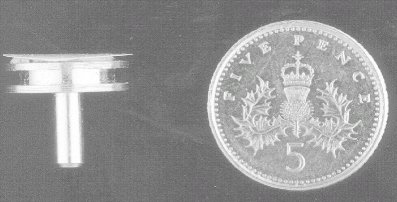 Our
work has been concerned with COARSE PARTICLES because the particles deposited
in dusty rooms are very large often in the 20-50 micron range. Such particles
cannot be monitored as concentations in the air with conventional high volume
samplers which are often unable to sample particles much above 15 microns. We
have been interested in the way in which dust coveres objects and concerned
with the area covered as a surrogate for soiling. Area proves relatively robust
as an indicator because contrast change is dependent on area yet independent
of particle brightness.
Our
work has been concerned with COARSE PARTICLES because the particles deposited
in dusty rooms are very large often in the 20-50 micron range. Such particles
cannot be monitored as concentations in the air with conventional high volume
samplers which are often unable to sample particles much above 15 microns. We
have been interested in the way in which dust coveres objects and concerned
with the area covered as a surrogate for soiling. Area proves relatively robust
as an indicator because contrast change is dependent on area yet independent
of particle brightness.
Sticky samplers
The sticky samplers were made with 1.3cm diameter circles of
white sticky labels and attached to aluminum stubs using Blu-tack. The
assembled samplers were attached to wall or panels in horizontal orientation
with Blu-tack. These samplers were deployed ain three museums according
to the sampling strategies such as vertical and spatial profile including different
floor covering, different distance from visitor and different cleaning regimes.
After exposing for about 2 months, these were analysed using two different approaches.
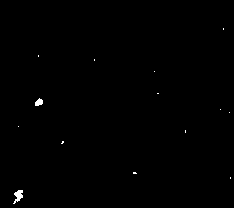 Imaging
Imaging
As you know, optical microscope is a manual method, which is
available to identify the particle types, colour and shape but there is a disadvantage;
it is very time consuming. Adobe Photo Shop is a semi-automatic method.
Fraction area covered can be measured automatically and counting through the
monitor screen also available, but it does not offer the single particle sizing.
SEMPER image analysis program allows particle counting, sizing and fraction
area covered measurement automatically. To prepare the image samples, photo
were made with same size and scanned with gray scale at high resolution. These
have adjusted to the same brightness and contrast and converted to negative
images using a Photo Shop. After this further image analysis used the
program SEMPER. An important thing is that white or light colour particles
such as quartz, gypsum, calcite and the white cloured fibres do not get detected.
This required that these particles were re-painted again in the Photo Shop.
Results
Correlation between manual and automatic method
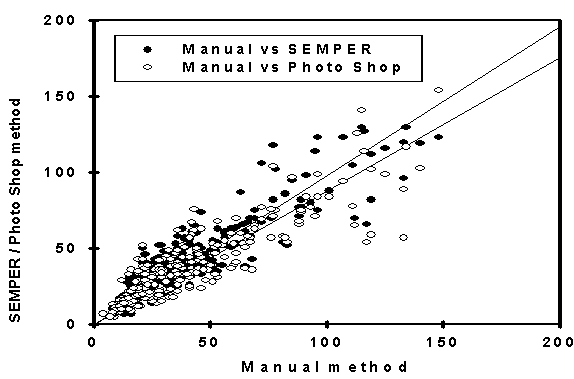 Correlation
between the manual counting through and eyepiece and SEMPER was found to be
0.87 (n=247), which is reasonably good agreement. As might be expected, the
counts witnessed by eye through a monitor screen also obviously showed good
correlation ( r2=0.81) also. These correlation are not perfect and some error
might be caused by photographic quality, scanning bias or thresholding intensity
in SEMPER, but perfect agreement is not unexpected given the way in which we
perceive fine particles under a microscope.
Correlation
between the manual counting through and eyepiece and SEMPER was found to be
0.87 (n=247), which is reasonably good agreement. As might be expected, the
counts witnessed by eye through a monitor screen also obviously showed good
correlation ( r2=0.81) also. These correlation are not perfect and some error
might be caused by photographic quality, scanning bias or thresholding intensity
in SEMPER, but perfect agreement is not unexpected given the way in which we
perceive fine particles under a microscope.
|
Correlation between number and area
|
| There is a reasonable agreement (R2=0.56)between fraction
area covered and number of particles |
Fibres which have highly variable length and so agreement is poor |
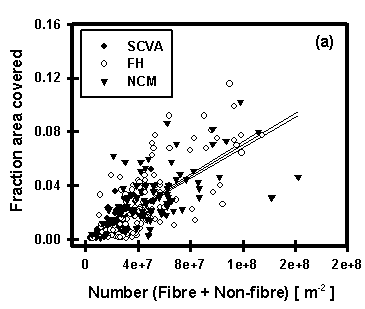 |
 |
 Vertical
profile
Vertical
profile
Particles deposited on the sticky samplers could be identified
under the microscope, as: soil dust, soot, fibres and more rarely dandruff,
plant and paint fragments, human hair, and insect parts.
All the profiles seem to have a similar characteristic shape,
with elevated rates at floor level and typically 0.8-1.5m height above the floor.
Our studies suggest that dust stirred from the floor by walking is most important
in the first 30 cm above the floor. This does not seem to rise to any great
height, perhaps only 20-30cm. This upward flux from the floor is probably of
limited importance in soiling in historic materials, because such items are
frequently found at eye-level. This means dust from the floor is not a primary
source of coarse particles at eye-level.
At eye level the deposit appears to contain fibres shed from
visitor's clothing, suggesting that they are the principal source. However,
carpet fibres are only found in the very lowest levels about 2-20 cm and would
clearly not affect normal eye-level objects on display. We can see the flux
of particles and fibres are very much lower in the unoccupied room. The result
shows that soiling decreases a factor of 14 and 17, for non-fibrous and fibrous
dust deposition, when the room is unoccupied. Note that only the occupied room
shows a clear maxima over the 80-150cm height range.
Floor covering
Conservators have long worried about the importance of floor
covering in controlling interior dust level. We examined dust deposition in
rooms with different floor coverings such as carpet, wood, stone, and rubber
tile. The soiling on a per capita basis shows very similar, although thel sampling
sites have different floors covering. An exception is the case of Drawing Room
(Fig. e), where samplers were 3-4m from visitors shows much lower covering rates
than in the South Corridor (Fig. g), where samplers were within 30 cm at the
same flow of visitors passed. Therefore, this result could prove that floor
type is not a significant factor.
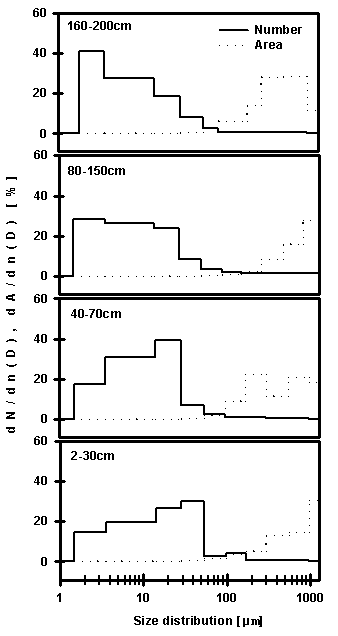
Size distribution
We also used SEMPER to class particle sizes on the sticky
samplers in all the vertical profiles from the buildings studied. We can see
that the smaller particles are most numerous in the highest elevation and the
height of eye-level, although the very finest would not be observed in our light
microscope. Close to the ground the most numerous particles are about 50 microns
and also the coarse fibres almost a millimetre long predominate. In general
it is fibres that make the largest contribution to covering the surface.
Impact of visitor

At
the moment, we can have a question that where is the main contributor to increase
the soiling degree at the eye level? To solve this question, we set samplers
out at regular intervals on the floor in transects at right angles to the cordoned
visitor pathway in the Felbrigg Hall.
This figure shows the covering rate as a function of distance
from visitors. It is plotted semi-ogarithmically to emphasise an apparent exponential
decrease with distance of about 1m. Transects from both the Drawing room and
Red bedroom show that the covering rate at floor level, declines by at least
a half with every half metre from the visitor path.
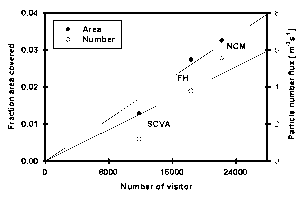 Correlation
between visitor and soiling (Soiling per capita)
Correlation
between visitor and soiling (Soiling per capita)
It was clear that visitor flow was a major contributor to soiling,
such that soiling mechanisms in different museums could be compared on a per
capita basis. The relationship between the average covering rate and particle
flux at the three sites yields a satisfying relationship with visitor number.
The high value in Norwich Castle Museum (NCM) seems to be an influence of the
large number of visitors.
|
Dust from clothing
|
|
Clearly support for the source of dust that soiling derives
from visitors comes from this close up photo of dust emerging from a woolen
coat. (Scale about 10cm).
|
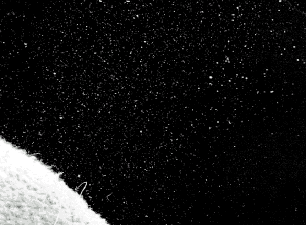 |
Conclusion and discussion
Sticky sampler - In this study, sticky samplers were used to measure the soiling potential in some museums and historic properties. Although sticky samplers have a problem if stickiness is lost, glass slides, which are frequently adopted in the museum environment, can lose larger particles. Furthermore sticky samplers have other advantages: 1) inexpensive 2) easy to make 3) high collection efficiency (stickiness of surface) 4) wide application (applicable for measuring particulate matter using SEM or image analysis) and 5) unobtrusive.
Visitor - It was clear that visitor flow was a major
contributor to soiling, such that soiling mechanisms in different museums could
be compared on a per capita basis. The proximity of visitors to objects was
another important factor with the soiling declining which suggests soiling of
objects on open display could be reduced by increasing the distance from visitors.
It impact of visitors on coarse dust deposition declines rapidly by a half for
each half metre from visitor pathways.
Vertical profile - Our studies suggest that dust stirred
from the floor by walking is most important in the first 30 cm above the floor.
At eye level the deposit appears to contain fibres shed from visitor's clothing,
suggesting that they are the principal source. Thus carpetting may not necessarily
be a critical source of dust for museums with eyelevel displays.
Soiling unit - The number of non-fibrous particles were
always higher than fibrous particles, but of course they were much smaller,
so simple particle counts expressed as particle number density and number flux
are not necessarily a good estimate of soiling. Firstly, we adopt fractional
area covered over the sampling period, but clearly this is better expressed
as a covering rate with the units, s-1 (i.e. dividing the
fraction covered by the number of seconds in the sampling period i.e. where
eight weeks, 5.184x106s). Our early study indicated that the visitor
is an important contributor to increase the dust level. Therefore, soiling could
be expressed in final with fraction area covered, which is calculated per capita
based.
Young Hun Yoon* and Peter Brimblecombe
School of Environmntal Sciences
University of Est Anglia
Norwich NR4 7TJ UK
e-mail * : y.h.yoon@uea.ac.uk
(*) Author to whom correspondence may be addressed

Index of presentations at IAQ2000 meeting
[ Page up ]
[ IAP Group homepage ]
[ Main IAQ in Museums homepage ]
[ Search site ]
Webmaster
Indoor Air Quality in Museums and Archives © 2000

 Our
work has been concerned with COARSE PARTICLES because the particles deposited
in dusty rooms are very large often in the 20-50 micron range. Such particles
cannot be monitored as concentations in the air with conventional high volume
samplers which are often unable to sample particles much above 15 microns. We
have been interested in the way in which dust coveres objects and concerned
with the area covered as a surrogate for soiling. Area proves relatively robust
as an indicator because contrast change is dependent on area yet independent
of particle brightness.
Our
work has been concerned with COARSE PARTICLES because the particles deposited
in dusty rooms are very large often in the 20-50 micron range. Such particles
cannot be monitored as concentations in the air with conventional high volume
samplers which are often unable to sample particles much above 15 microns. We
have been interested in the way in which dust coveres objects and concerned
with the area covered as a surrogate for soiling. Area proves relatively robust
as an indicator because contrast change is dependent on area yet independent
of particle brightness. Imaging
Imaging  Correlation
between the manual counting through and eyepiece and SEMPER was found to be
0.87 (n=247), which is reasonably good agreement. As might be expected, the
counts witnessed by eye through a monitor screen also obviously showed good
correlation ( r2=0.81) also. These correlation are not perfect and some error
might be caused by photographic quality, scanning bias or thresholding intensity
in SEMPER, but perfect agreement is not unexpected given the way in which we
perceive fine particles under a microscope.
Correlation
between the manual counting through and eyepiece and SEMPER was found to be
0.87 (n=247), which is reasonably good agreement. As might be expected, the
counts witnessed by eye through a monitor screen also obviously showed good
correlation ( r2=0.81) also. These correlation are not perfect and some error
might be caused by photographic quality, scanning bias or thresholding intensity
in SEMPER, but perfect agreement is not unexpected given the way in which we
perceive fine particles under a microscope. 

 Vertical
profile
Vertical
profile

 Correlation
between visitor and soiling (Soiling per capita)
Correlation
between visitor and soiling (Soiling per capita)